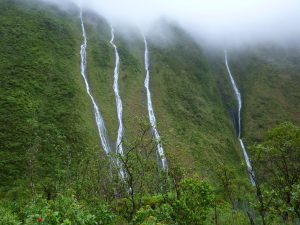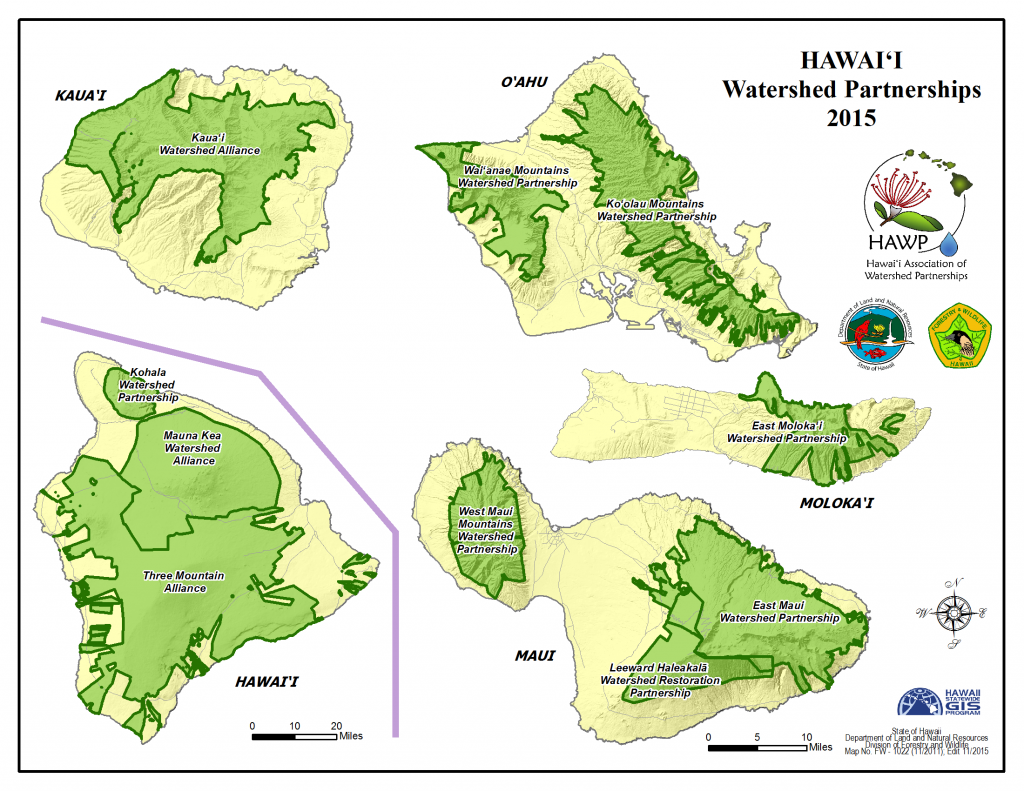Watershed Partnerships Program

The Watershed Partnerships Program provides technical and financial support for the implementation of watershed management plans. Watersheds are areas of land from which water drains to a common outlet. In Hawaiʻi, our watershed forests are our only source of fresh water, and are critical to the survival of all life in the islands. Click here to learn more about watersheds and how they function. Below you can learn about how the Division of Forestry & Wildlife works with partners to manage these important areas.
What are Watershed Partnerships?

Waterfalls on Kauaʻi
The first Watershed Partnership was formed in 1991 on East Maui when several public and private landowners realized the benefits of working together to ensure the conservation of a shared watershed that provided billions of gallons of fresh water to the area. Today, Watershed Partnerships continue to be voluntary alliances of public and private landowners committed to the common value of protecting forested watersheds for water recharge and other ecosystem services through collaborative management. There are ten Watershed Partnerships across Hawaiʻi. There are over 70 public and private landowners and partners involved with over 2 million acres included in Watershed Partnerships. Not only are these areas vital recharge regions for Hawai‘i’s underground aquifers and a dependable source of clean water for its streams and people, they are also home to the last remaining native ecosystems in Hawai‘i and house thousands of native species of animals and plants found no where else on earth. In addition to providing such services, these areas also provide an opportunity for the education of children about Hawai‘i’s unique environments and conservation related jobs.
Benefits of Watershed Partnerships

In native forests, mosses like these play an important role in water capture from fog and clouds
Less than 40 percent of Hawai‘i’s native habitats remain today. However, much of this remaining 40 percent can be found as part of landscapes under Watershed Partnerships. Habitats found in Watershed Partnerships range from mesic koa -‘ohi‘a forests to cliffs, from subalpine shrublands to grasslands, from dry forests to young lava flows and tubes, and from wetland bogs to coastal systems. Virtually almost every natural community type found in Hawai‘i can be found in the Watershed Partnerships. Additionally, 239 threatened and endangered plants and animals (nearly 20% of the nation’s total listed species), 499 rare plants and animals, and hundreds of other common native species can be found in partnership areas as well. Most management actions are habitat based and revolve around combating the main threats of ungulate (hooved animals such as goats, deer, sheep, pigs, etc.) and invasive species. Examples include ungulate removal, invasive species control, outplanting, and restoration. Not only do these management actions benefit native forests and watersheds, but they also benefit our coastal and coral reef areas as well by reducing erosion and sedimentation effects in streams and during heavy rains.
Watershed Partnerships are critical to protecting watersheds and their unique biodiversity across large landscapes and different ownership boundaries. The benefits of collaborative management practiced under Watershed Partnerships are many:
- management actions address large landscapes and threats affecting multiple habitats and species;
- they leverage limited dollars for maximum benefits and allow the pooling of resources as well as expertise to reduce redundancy efforts;
- provide capacity building for landowners; and
- actions conserve other ecosystem services such as water, recreation, culture, education, and jobs. [1]
For more information on the Watershed Partnerships Program, please contact the Division of Forestry and Wildlife.
[1] In a 1999 University of Hawai‘i study on valuating such ecosystems services provided by Hawai‘i’s watersheds, the Ko‘olau Mountains on O‘ahu were valued at $7.4-14 billion dollars.
The Partnerships
To address statewide issues, the Hawai‘i Association of Watershed Partnerships (HAWP) was established in 2003 to build public and private support for watershed protection. HAWP is comprised of the Watershed Partnerships and works to develop the capacity of these partnerships to manage and protect our native forested watersheds.
Visit the HAWP website to learn more about each partnership. You can also learn more from our Watershed Partnerships brochure.
